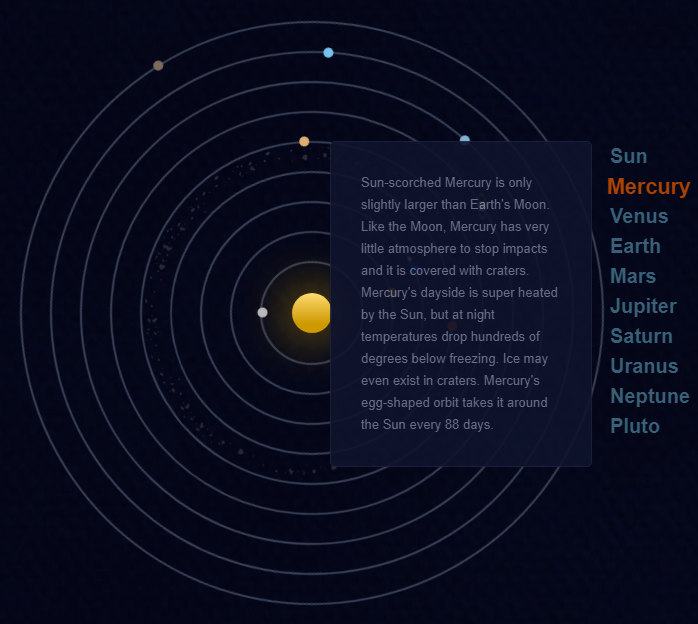以下是 CSS3实现太阳星系运转特效代码 的示例演示效果:
部分效果截图:

HTML代码(index.html):
<!DOCTYPE html>
<html lang="en">
<head>
<title>CSS3实现太阳星系运转特效</title>
<meta http-equiv="content-type" content="text/html; charset=utf-8" />
<link rel="stylesheet" type="text/css" media="screen,projection" href="css/styles.css" />
</head>
<body>
<div class="wrap clearfix">
<section class="clearfix">
<ul class="solarsystem">
<li class="sun"><a href="#sun"><span>Sun</span></a></li>
<li class="mercury"><a href="#mercury"><span>Mercury</span></a></li>
<li class="venus"><a href="#venus"><span>Venus</span></a></li>
<li class="earth"><a href="#earth"><span>Earth<span class="moon"> &
Moon</span></span></a></li>
<li class="mars"><a href="#mars"><span>Mars</span></a></li>
<li class="asteroids_meteorids"><span>Asteroids & Meteorids</span></li>
<li class="jupiter"><a href="#jupiter"><span>Jupiter</span></a></li>
<li class="saturn"><a href="#saturn"><span>Saturn &
<span class="ring">Ring</span></span></a></li>
<li class="uranus"><a href="#uranus"><span>Uranus</span></a></li>
<li class="neptune"><a href="#neptune"><span>Neptune</span></a></li>
<li class="pluto"><a href="#pluto"><span>Pluto</span></a></li>
</ul>
<ul id="descriptions">
<li>
<h2 id="sun">Sun</h2>
<p>The Sun is a star, a hot ball of glowing gases at the heart of our solar
system. Its influence extends far beyond the orbits of distant Neptune and
Pluto. Without the Sun's intense energy and heat, there would be no life
on Earth. And though it is special to us, there are billions of stars like
our Sun scattered across the Milky Way galaxy.</p>
</li>
<li>
<h2 id="mercury">Mercury</h2>
<p>Sun-scorched Mercury is only slightly larger than Earth's Moon. Like
the Moon, Mercury has very little atmosphere to stop impacts and it is covered
with craters. Mercury's dayside is super heated by the Sun, but at night
temperatures drop hundreds of degrees below freezing. Ice may even exist
in craters. Mercury's egg-shaped orbit takes it around the Sun every 88
days.</p>
</li>
<li>
<h2 id="venus">Venus</h2>
<p>Venus is a dim world of intense heat and volcanic activity. Similar in
structure and size to Earth, Venus' thick, toxic atmosphere traps heat in
a runaway 'greenhouse effect.' The scorched world has temperatures hot enough
to melt lead. Glimpses below the clouds reveal volcanoes and deformed mountains.
Venus spins slowly in the opposite direction of most planets.</p>
</li>
<li>
<h2 id="earth">Earth</h2>
<p>Earth is an ocean planet. Our home world's abundance of water - and life
- makes it unique in our solar system. Other planets, plus a few moons,
have ice, atmospheres, seasons and even weather, but only on Earth does
the whole complicated mix come together in a way that encourages life -
and lots of it.</p>
</li>
<li>
<h2 id="mars">Mars</h2>
<p>Though details of Mars' surface are difficult to see from Earth, telescope
observations show seasonally changing features and white patches at the
poles. For decades, people speculated that bright and dark areas on Mars
were patches of vegetation, that Mars could be a likely place for life-forms,
and that water might exist in the polar caps. When the Mariner 4 spacecraft
flew by Mars in 1965, many were shocked to see photographs of a bleak, cratered
surface. Mars seemed to be a dead planet. Later missions, however, have
shown that Mars is a complex member of the solar system and holds many mysteries
yet to be solved.</p>
</li>
<li>
<h2 id="jupiter">Jupiter</h2>
<p>The most massive planet in our solar system, with four large moons and
many smaller moons, Jupiter forms a kind of miniature solar system. Jupiter
resembles a star in composition. In fact, if it had been about 80 times
more massive, it would have become a star rather than a planet.</p>
</li>
<li>
<h2 id="saturn">Saturn</h2>
<p>Saturn was the most distant of the five planets known to the ancients.
Like Jupiter, Saturn is made mostly of hydrogen and helium. Its volume is
755 times greater than that of Earth. Winds in the upper atmosphere reach
500 meters (1,600 feet) per second in the equatorial region. These super-fast
winds, combined with heat rising from within the planet's interior, cause
the yellow and gold bands visible in the atmosphere.</p>
</li>
<li>
<h2 id="uranus">Uranus</h2>
<p>The first planet found with the aid of a telescope, Uranus was discovered
in 1781 by astronomer William Herschel. The seventh planet from the Sun
is so distant that it takes 84 years to complete one orbit.</p>
</li>
<li>
<h2 id="neptune">Neptune</h2>
<p>Nearly 4.5 billion kilometers (2.8 billion miles) from the Sun, Neptune
orbits the Sun once every 165 years. It is invisible to the naked eye because
of its extreme distance from Earth. Interestingly, the unusual elliptical
orbit of the dwarf planet Pluto brings Pluto inside Neptune's orbit for
a 20-year period out of every 248 Earth years</p>
</li>
<li>
<h2 id="pluto">Pluto</h2>
<p>Tiny, cold and incredibly distant, Pluto was discovered in 1930 and long
considered to be the ninth planet. But after the discoveries of similar
intriguing worlds even farther out, Pluto was reclassified as a dwarf planet.
This new class of worlds may offer some of the best evidence of the origins
of our solar system.</p>
</li>
</ul>
</section>
</div>
</body>
</html>
CSS代码(styles.css):
*{margin:0;padding:0;}
body{font:14px/1.5 "Helvetica Neue",Helvetica,Arial,sans-serif;background:#080e24 url(bg.jpg) repeat;color:#626668;}
div.wrap{width:960px;margin:0 auto;padding:60px 0;}
a.about,a.twitter{display:block;position:fixed;bottom:20px;right:20px;background:#32312b;padding:7px 28px;text-decoration:none;color:#eee5a2;font-size:12px;-webkit-border-radius:20px;-moz-border-radius:20px;border-radius:20px;-webkit-transition:all 0.15s ease-in;-moz-transition:all 0.15s ease-in;-o-transition:all 0.15s ease-in;transition:all 0.15s ease-in;}
a.twitter{right:220px;}
a.about:hover,a.twitter:hover{background:#aa4200;color:#fff;}
section{display:block;position:relative;}
header{text-align:center;}
header h1{font-size:126px;line-height:1;color:#eee5a2;text-transform:uppercase;text-shadow:5px 5px #32312b;}
header p{font-size:24px;color:#6a695f;margin:0 0 10px;}
header p.disclaimer{font-size:13px;color:#33373d;}
/* Solar System Styles */
ul.solarsystem{position:relative;height:640px;list-style:none;-webkit-transition:all 0.09s ease-in;-moz-transition:all 0.09s ease-in;-o-transition:all 0.09s ease-in;transition:all 0.09s ease-in;overflow:hidden;}
ul.solarsystem li{text-indent:-9999px;display:block;position:absolute;border:2px solid #394057;/* opacity:0.7;*/
}
ul.solarsystem li span{display:block;position:absolute;width:10px;height:10px;-webkit-border-radius:5px;-moz-border-radius:5px;border-radius:5px;}
ul.solarsystem li.active{border-color:#aa4200;}
ul.solarsystem li.active.sun,ul.solarsystem li.active span{-webkit-transform:scale(1.3);-moz-transform:scale(1.3);-o-transform:scale(1.3);transform:scale(1.3);}
ul.solarsystem li.active.sun span,ul.solarsystem li.active.earth .moon{border:none;-webkit-box-shadow:none;-moz-box-shadow:none;box-shadow:none;}
ul.solarsystem li.sun{width:40px;height:40px;-webkit-border-radius:20px;-moz-border-radius:20px;border-radius:20px;background:#fc3;background-image:-webkit-gradient( linear,left bottom,left top,color-stop(0.22,rgb(204,153,0)),color-stop(1,rgb(255,219,112)) );background-image:-moz-linear-gradient( center bottom,rgb(204,153,0) 22%,rgb(255,219,112) 100% );top:302px;left:462px;border:none;-webkit-box-shadow:0 0 50px #c90;-moz-box-shadow:0 0 50px #c90;box-shadow:0 0 50px #c90;z-index:100;-webkit-transition:all 0.2s ease-in;-moz-transition:all 0.2s ease-in;-o-transition:all 0.2s ease-in;transition:all 0.2s ease-in;}
ul.solarsystem li.sun span{width:60px;height:60px;-webkit-border-radius:30px;-moz-border-radius:30px;border-radius:30px;}
ul.solarsystem li.mercury{width:100px;height:100px;-webkit-border-radius:52px;-moz-border-radius:52px;border-radius:52px;top:270px;left:430px;z-index:99;}
ul.solarsystem li.mercury span{background:#b6bac5;top:10px;left:10px;}
ul.solarsystem li.venus{width:160px;height:160px;-webkit-border-radius:82px;-moz-border-radius:82px;border-radius:82px;top:240px;left:400px;z-index:98;}
ul.solarsystem li.venus span{background:#bf8639;top:118px;left:5px;}
ul.solarsystem li.earth{width:220px;height:220px;-webkit-border-radius:112px;-moz-border-radius:112px;border-radius:112px;top:210px;left:370px;z-index:97;}
ul.solarsystem li.earth span{background:#06c;top:56px;left:5px;}
ul.solarsystem li.earth span.moon{width:4px;height:4px;-webkit-border-radius:2px;-moz-border-radius:2px;border-radius:2px;background:#ccc;top:12px;left:12px;}
ul.solarsystem li.mars{width:280px;height:280px;-webkit-border-radius:142px;-moz-border-radius:142px;border-radius:142px;top:180px;left:340px;z-index:96;}
ul.solarsystem li.mars span{background:#aa4200;top:0px;left:175px;}
ul.solarsystem li.asteroids_meteorids{top:155px;left:315px;z-index:1;background:url(asteroids_meteorids.png) no-repeat 0 0;width:330px;height:330px;-webkit-border-radius:165px;-moz-border-radius:165px;border-radius:165px;border:none;}
ul.solarsystem li.jupiter{width:340px;height:340px;-webkit-border-radius:172px;-moz-border-radius:172px;border-radius:172px;top:150px;left:310px;z-index:95;}
ul.solarsystem li.jupiter span{background:#e0ae6f;top:67px;left:24px;}
ul.solarsystem li.saturn{width:400px;height:400px;-webkit-border-radius:202px;-moz-border-radius:202px;border-radius:202px;top:120px;left:280px;z-index:94;}
ul.solarsystem li.saturn span{background:#dfd3a9;top:24px;left:300px;}
ul.solarsystem li.saturn span.ring{width:12px;height:12px;-webkit-border-radius:8px;-moz-border-radius:8px;border-radius:8px;background:none;border:2px solid #5a4e34;left:-3px;top:-3px;-webkit-transform:skewY(50deg);-moz-transform:skewY(50deg);-o-transform:skewY(50deg);transform:skewY(50deg);}
ul.solarsystem li.uranus{width:460px;height:460px;-webkit-border-radius:232px;-moz-border-radius:232px;border-radius:232px;top:90px;left:250px;z-index:93;}
ul.solarsystem li.uranus span{background:#82b3d1;top:7px;left:300px;}
ul.solarsystem li.neptune{width:520px;height:520px;-webkit-border-radius:262px;-moz-border-radius:262px;border-radius:262px;top:60px;left:220px;z-index:92;}
ul.solarsystem li.neptune span{background:#77c2ec;top:0px;left:200px;}
ul.solarsystem li.pluto{width:580px;height:580px;-webkit-border-radius:292px;-moz-border-radius:292px;border-radius:292px;top:30px;left:190px;z-index:91;}
ul.solarsystem li.pluto span{background:#7c6a5c;top:79px;left:79px;}
ul#descriptions{position:absolute;top:150px;right:100px;list-style:none;}
ul#descriptions h2{cursor:pointer;color:#386077;-webkit-transition:all 0.15s ease-in;-moz-transition:all 0.15s ease-in;-o-transition:all 0.15s ease-in;transition:all 0.15s ease-in;font-size:20px;position:relative;z-index:101;-webkit-transform:scale(1);-moz-transform:scale(1);-o-transform:scale(1);transform:scale(1);}
ul#descriptions h2:hover{color:#aa4200;-webkit-transform:scale(1.08);-moz-transform:scale(1.08);-o-transform:scale(1.08);transform:scale(1.08);}
ul#descriptions li p{position:absolute;left:-250px;top:0;width:200px;display:inline;opacity:0;visibility:hidden;font-size:13px;-webkit-border-radius:5px;-moz-border-radius:5px;border-radius:5px;-webkit-transition:all 0.3s ease-in;-moz-transition:all 0.3s ease-in;-o-transition:all 0.3s ease-in;transition:all 0.3s ease-in;background:#0f132c;padding:30px;color:#767892;line-height:1.7;z-index:100;border:1px solid #1c203c;}
ul#descriptions h2:hover+p{visibility:visible;opacity:0.9;left:-280px;}
/* CSS3 Animations */
ul.solarsystem li{-webkit-animation-iteration-count:infinite;-webkit-animation-timing-function:linear;-webkit-animation-name:orbit;-moz-animation-iteration-count:infinite;-moz-animation-timing-function:linear;-moz-animation-name:orbit;}
ul.solarsystem li.earth span{-webkit-animation-iteration-count:infinite;-webkit-animation-timing-function:linear;-webkit-animation-name:moon;-moz-animation-iteration-count:infinite;-moz-animation-timing-function:linear;-moz-animation-name:moon;}
ul.solarsystem li.mercury{-webkit-animation-duration:5s;-moz-animation-duration:5s;}
ul.solarsystem li.venus{-webkit-animation-duration:8s;-moz-animation-duration:8s;}
ul.solarsystem li.earth{-webkit-animation-duration:12s;-moz-animation-duration:12s;}
ul.solarsystem li.earth span{-webkit-animation-duration:2s;-moz-animation-duration:2s;}
ul.solarsystem li.mars{-webkit-animation-duration:20s;-moz-animation-duration:20s;}
ul.solarsystem li.asteroids_meteorids{-webkit-animation-duration:50s;-moz-animation-duration:50s;}
ul.solarsystem li.jupiter{-webkit-animation-duration:30s;-moz-animation-duration:30s;}
ul.solarsystem li.saturn{-webkit-animation-duration:60s;-moz-animation-duration:60s;}
ul.solarsystem li.uranus{-webkit-animation-duration:70s;-moz-animation-duration:70s;}
ul.solarsystem li.neptune{-webkit-animation-duration:100s;-moz-animation-duration:100s;}
ul.solarsystem li.pluto{-webkit-animation-duration:120s;-moz-animation-duration:120s;}
@-webkit-keyframes orbit{from{-webkit-transform:rotate(0deg)}
to{-webkit-transform:rotate(360deg)}
}
@-webkit-keyframes moon{from{-webkit-transform:rotate(0deg)}
to{-webkit-transform:rotate(360deg)}
}
@-moz-keyframes orbit{from{-moz-transform:rotate(0deg)}
to{-moz-transform:rotate(360deg)}
}
@-moz-keyframes moon{from{-moz-transform:rotate(0deg)}
to{-moz-transform:rotate(360deg)}
}
/*ul.solarsystem:hover li{-webkit-animation-play-state:paused;}
*/
/* iPad Specific */
@media only screen and (max-device-width:1024px){p.links{text-align:center;width:350px;margin:0 auto;}
a.about,a.twitter{position:static;text-align:left;margin:0 10px 0 0;float:left;}
}


